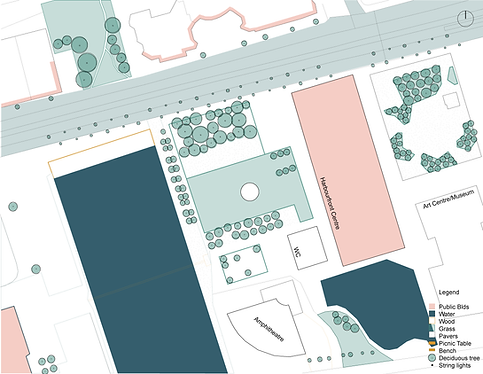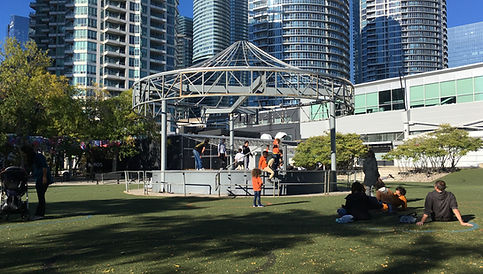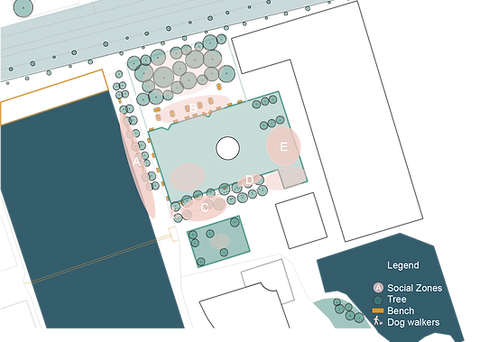Ann Tindal
Toronto, ON
The green space is part of the larger series of Harbourfront urban spaces along Lake Ontario. The park is located at the long side of the Harbourfront Community Centre and is used as an event space for the community.
The Ann Tindal Park is one of the many parks found along Toronto’s Harbourfront that is known for its community and tourism. Ann Tindal Park is both a combination of public and private zones as it is a social events space and a quieter destination by the water. The main street Queens Quay along the waterfront is always busy with vehicular traffic, pedestrians and cyclists. The park is hidden from the East side, but the space is fully visible from the West. The green event space of the park is recessed behind trees and the Harbourfront Community Centre building. From within the green space, the park is not closed off and there were a few people who were sitting and enjoying the peace of the space throughout the day. In this sense, the space may not be as successful without an event or a crowd due to being partially hidden and setback. There was an older Korean family talking and meeting up on two benches which is one of the few specific examples when the park was used as a meeting place. The main pathways are successful in leading people in lines towards the open larger walkway along the water.

Figure 2.1: Harbourfront’s Ann Tindal Park and the Toronto Waterfront surrounding context at 1:1000 (Chin, Sarah, “Ann Tindal Park”, September 20, 2020)
The Queens Quay main street is successful for lanes of vehicles, streetcars, cyclists, and pedestrians that are widely spaced. The successful lanes of transportation allow for choices of roaming or going from destination to destination. The Downtown Parks and Public Realm Plan: Public Space Public Life Study noted that there are 29% more people on weekends with the streets being 40% 15-30 year old, representing what I had observed quantitatively. [1] The park achieves attracting residents and the area in a larger context is more successful at attracting both locals and tourists. Queens Quay street is one of the major bike lanes in Toronto and attracts people from all over to cycle and explore the Harbourfront.[2] The park considers its edge conditions by having edges and borders that delineate the exchange zones compared to the staying zones.[3]
In the afternoon, there are a few more people than the morning observation and people are mainly sitting. There are more people sitting at the picnic tables due to it being a late lunch time and the activity of eating allows for more interactions. The activity of eating is categorized with the role of natural elements according to William Whyte as something that attracts and is an attraction for people.[3] The range of food shops nearby allowed two male teenagers to sit and eat their food at the picnic table nearest to the green space and even feed some to a pigeon. The food created a reason and opportunity for them to eat outside and the park created the space and possibility for interaction with nature and animals. The Harbourfront location is successful based on the 11 principles for creating great places in achieving a place for community and events, where people do use the space as a meeting destination and transition space.[4] The 11 principles for creating great places that Ann Tindal achieves are the community that exists among the people, creating a place that allows for flexibility and exploration without over-designing the space, there are many partners and people involved in making the waterfront an enjoyable place, and there is triangulation that encourages people to stay and talk.[5] The well-designed space promotes healthy active living while still having opportunities for exploration and straying from the path.
There were several children at all observation hours, which I noted that they are naturally drawn to the grass slope and open pavilion. Some people feel comfortable relocating from one side to another side of the space after sitting down. Most people feel comfortable using it as a transition space. Adults are intrigued by the slope space but often do not explore unless a dog owner or following their children. Mothers with their strollers tend to sit on the same few benches in Zone B that are further back and close to the slope. Children also attract other children, which created Zone F for where play occurred. In Zone C, the ground surface changes from grass to a section of pavers shaded by trees next to the green space, where dogs and cyclists tend to gather or circle. The Ann Tindal park and Zone C is a popular spot for dog owners and cyclists for a paved sheltered area to pause.
Undesignated zones are created by the areas where people are naturally drawn based on activity type. The park’s built incline form draws children and dog owners to behave by playing and rolling down the hill in a reciprocal relationship.[5] The minimal topography and open green space replace the need for a playground within the space and adds to Simeon Packard’s term of the play diet.[6] The experience and opportunities for children to play are crucial to keeping an active lifestyle and maintaining good physical and mental health.[7] The slope allows for more creative play experiences as it is less direct than a playground and allows people of all ages to interact. As Jenny Donovan says about the importance of fun and exploration in a child’s development, “Play is the way that children learn about themselves and the world they live in.”[8] In my opinion it is decently successful as it allows for opportunities and exploration without the defined play of a playground.

Sound
A spontaneous, community-led dance session by young adults that brought interaction from passersby and the children playing in the park.

Figure 2.2: Circulation diagram of pedestrian, cyclists, and specific park movement that remained the same all day. (Chin, Sarah, “Ann Tindal Park”, September 20, 2020)

The most popular area of the park is the walkway next to water. The pedestrians and cyclists range in age, ethnicity, and group sizes.

The slight slope due to the change in elevation creates a zone for play within the park that does not have a playground.
In the evening, a spontaneous event occurred where young adult hip-hop dancers were dancing on the open round pavilion. The dancers were playing music at a volume that softly carried throughout the space and attracted the attention of everybody. Jan Gehl’s idea of triangulation was created when the dancers rehearsed on the small stage which created conversations, pauses, and people sitting to watch the impromptu event. [9] Most people sat where there were benches or picnic tables, only people who sat on grass were two Quebecois families with young children. The people who mingled on the open grass area played on the notion of conventional seating, but was mainly used by those who felt comfortable in the space, which were typically pairs, groups, or dog owners and were able to sit and interact. The small children interacted and surrounded the stage of dancers and participated. Families spend a longer amount of time enjoying the space, they buy ice cream or relax while children play, rather than adults. The large open grass space is occupied for events typically in the summer, but most people may shy away from crossing it. The exceptions for the odd person or child who will diagonally cross the space as a shortcut or for fun. The diversity that the park experienced is a reflection of the city and the people who live in Toronto. The space without an event was used mainly as a transition space and less so as a resting space with high traffic along the pathways along the water.

Figure 2.3: Zone diagram created by human activity and undefined boundaries (Chin, Sarah, “Ann Tindal Park Zones”, September 20, 2020)
The seating around the park is well placed for keeping personal space proxemics and for viewer safety based on the prospect-refuge theory.[10] The bench placements allow for the users to view out towards the action of the pathway and are protected by the trees and the 2m space between them. The benches surrounding the green event area are successful in looking towards the action at the centre but fail to provide a feeling of safety by facing away from the central circulation.
All benches face away from action of the circulation or the event space, so users must have some level of comfort. If they are planning to stay for a longer period of time, users will sit near event space benches. Most people sat on benches facing the pathway and the water, where the action and the peace of the water reassured safety and comfort. Jane Jacob’s phrase of eyes on the street is significant for the park users to feel as safe as they do at Harbourfront. The scale of the distance between benches makes the space feel comfortable even with people next to you. William H. Whyte states that, “People tend to sit where there are places to sit”, an obvious but very true statement.[11] Few people who are alone sit on benches to read, eat, watch, or use as transition compared to many people who do activity in groups. In my opinion, the fluctuation of busy and not busy is a good thing as the city can often feel overcrowded and larger open green spaces are needed. The medium-sized well-proportioned green space does not make the open park feel uncomfortable or alienated.

The outdoor amphitheatre that provides shelter and a stage for large events adjacent to the green space. The park and amphitheatre are located along the water which encourages people to Harbourfront.

[1] Gehl Studio, Publicwork, “Downtown Parks and Public Realm Plan: Public Space Public Life Study” (Toronto, 2018)
[2] Ibid.
[3] Emilie Pinard, “Social: Public Space & Placemaking” (Class Lecture, Laurentian University, October 2020).
[4] William H. Whyte, Social Life of Small Urban Spaces, directed/performed by William H. Whyte (1979; Los Angeles: Direct Cinema Ltd., 1980), VHS.
[5] Emilie Pinard, “Social: Public Space & Placemaking” (Class Lecture, Laurentian University, October 2020).
[6] Jenny Donovan, Designing the Compassionate City: Creating Places Where People Thrive. (Place of publication: Routledge, 2017), 65.
[7] Emilie Pinard, “Healthy: Happiness and Well-Being” (Class Lecture, Laurentian University, October 2020).
[8] Jenny Donovan, Designing the Compassionate City: Creating Places Where People Thrive. (New York: Routledge, 2018), 65.
[9] Jan Gehl, Life Between Buildings. (Washington: Island Press, 2011), 29.
[10] Emilie Pinard, “Social: Public Space & Placemaking” (Class Lecture, Laurentian University, October 2020).
[11] William H. Whyte, Social Life of Small Urban Spaces, directed/performed by William H. Whyte (1979; Los Angeles: Direct Cinema Ltd., 1980), VHS.



